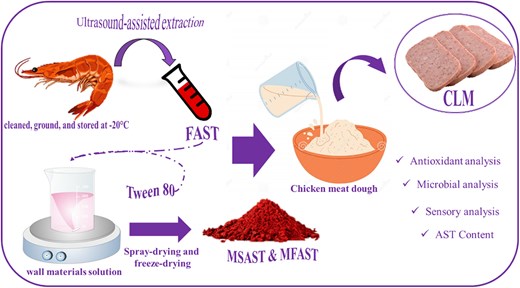-
Views
-
Cite
Cite
Parvin Sharayei, Elham Azarpazhooh, Fatemeh Zare, Yeganeh Sabeghi, Analysis of the preservation of the antioxidant, antimicrobial and sensory capacity of free and microencapsulated shrimp shell extract applied in chicken lunch meat, Translational Food Sciences, 2025;, vxaf006, https://doi.org/10.1093/trfood/vxaf006
Close - Share Icon Share
Abstract
This study investigated the effects of free astaxanthin (FAST) and its microencapsulated forms, namely freeze-dried astaxanthin (MFAST) and spray-dried astaxanthin (MSAST), on the quality, antioxidant properties, and sensory attributes of chicken lunch meat (CLM) over a duration of 45-days period at 4°C, and were compared along with synthetic sodium nitrate and a control sample. The results demonstrated that astaxanthin (AST) levels in CLMs decreased during storage; however, microencapsulation significantly preserved approximately twice as much AST compared to CLMs containing free AST. Samples containing AST showed significantly higher antioxidant activity compared to both the control and sodium nitrate samples. Among the treatments. MFAST treatment showing the highest activity, approximately 44% greater than FAST treatment. Microbial growth rate increased over time, ranging from 2.82 ± 0.03 |${\log}_{10}^{\mathrm{CFU}/\mathrm{g}}$|on the first day to over 5.35±0.04 |${\log}_{10}^{\mathrm{CFU}/\mathrm{g}}$|on day 45, while still remaining within acceptable microbial limits. In terms of sensory attributes, the FAST treatment at different concentrations resulted in moderately acceptable levels, however, the MFAST and MSAST treatments at higher concentrations received excellent scores. These findings highlight the potential of microencapsulation as a valuable technique for preserving AST and developing high-quality meat products with extended shelf life and enhanced sensory characteristics.




